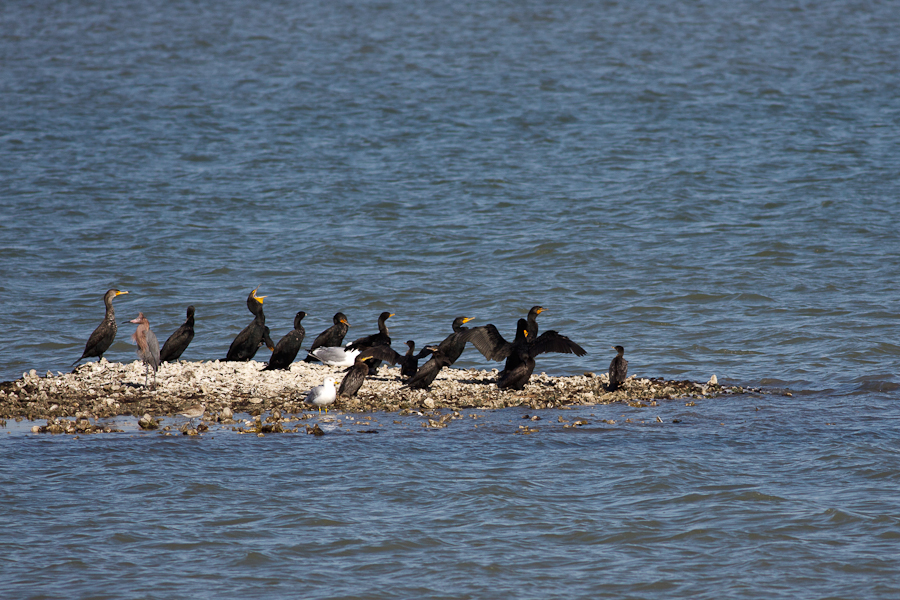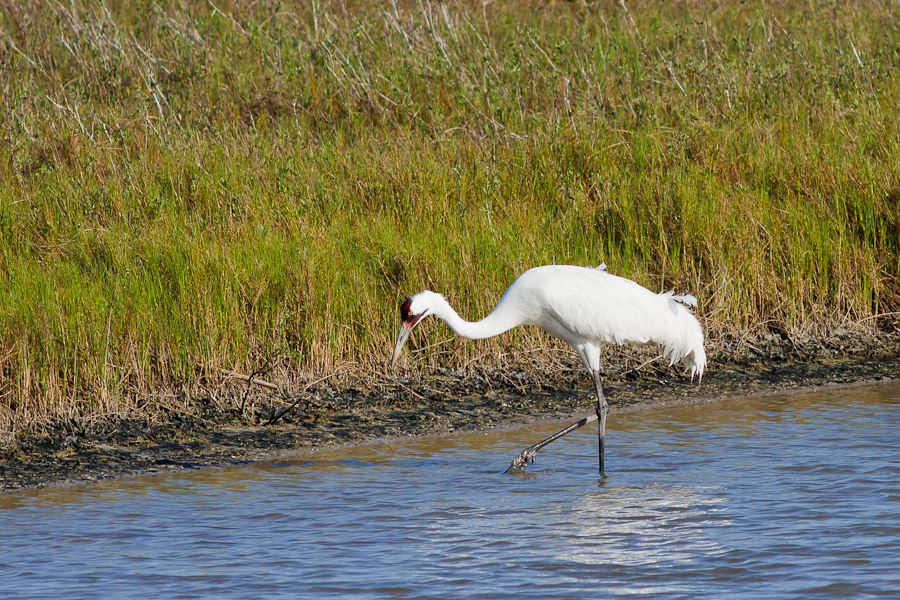#523-#525 on a Boat
Friday I got up bright and early for the real highlight of the trip: a boat ride through the Aransas National Wildlife Refuge to to find Whopping Cranes. When I awoke Port A. was covered in fog, and driving to the dock was a little tricky. (I got lost twice.) By the time I found it, the fog was still pretty thick. I could see a raptor on top of a nearby telephone pole, but could at best guess it was some kind of Buteo, probably a Red-tailed Hawk but I’m not sure. Similarly I could only guess that the cormorant across the harbor was a Double-crested.
I noticed some of my fellow passengers had tripods and scopes. I’ve never brought a tripod on a boat before, but after checking with them, they seemed to think it would be possible to use, so I grabbed mine out of the rental car. Fortunately I hadn’t left it in my hotel room.
We traveled for quite while before the fog burned off, but once it did we started seeing birds, mostly gulls, a few terns, and not much else until we reached the refuge. Once we got there though there started to be some interesting birds on some small sandbars, and on about the third sandbar we passed there were cormorants of two sizes! That meant the smaller ones were Neotropic Cormorants, #523:

A little further into the refuge, we saw our first Whooping Crane, #524:

These impressive birds stand about 5 feet tall, and need about 300 acres per family, and have very specific habitat requirements. At the rate they’re increasing (about 4% per year) they’re about 25 years away from occupying all available habitat, and that’s assuming that a lot still in private hands on the Lamar Peninsula is preserved, and that increasingly warm winters don’t allow Mangroves to encroach into their existing habitat. They’ve recovered from their low point in the 1940s but it’s still touch and go. One bad oil spill (the Intracoastal Waterway goes straight through the Aransas Wildlife Refuge) could wipe out most of the population. There are efforts underway to establish new populations in Florida and Louisiana. So far these haven’t been hugely successful. There are also about 160 or so cranes in zoos around the world.
We spent a couple of hours enjoying the cranes as well as various shorebirds, herons, and egrets. Not long after the boat turned around and headed back to port a strange-looking Buteo flew over. The leader called it; White-tailed Hawk, #525 and a completely unexpected bonus for the trip. I did not manage to get a photo of this one though. Next trip!
From the boat we saw about 41 total species:
- Gadwall
- Northern Pintail
- Redhead
- Lesser Scaup
- Bufflehead
- Common Goldeneye
- Red-breasted Merganser
- Neotropic Cormorant
- Double-crested Cormorant
- American White Pelican
- Brown Pelican
- Great Blue Heron
- Great Egret
- Snowy Egret
- Little Blue Heron
- Tricolored Heron
- Reddish Egret
- White Ibis
- White-faced Ibis
- Roseate Spoonbill
- Black Vulture
- Turkey Vulture
- Osprey
- White-tailed Hawk
- Red-tailed Hawk
- Whooping Crane
- Killdeer
- American Oystercatcher
- Greater Yellowlegs
- Willet
- Long-billed Curlew
- peep sp.
- Bonaparte’s Gull
- Laughing Gull
- Ring-billed Gull
- Herring Gull
- Caspian Tern
- Forster’s Tern
- Royal Tern
- Sandwich Tern
- Boat-tailed Grackle
- Great-tailed Grackle
(I may have missed one or two other folks saw.)
We got back around noon. Afternoon trips included a jaunt around local hot spots and another boat ride in the harbor to look for Atlantic Bottlenose Dolphins. Lots of fun but no new life birds. Tomorrow: Fennessey Ranch and completely different habitat (plus more cranes.)
